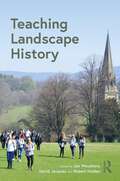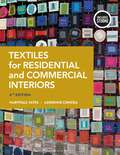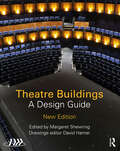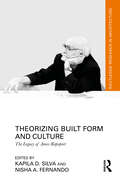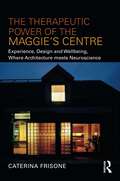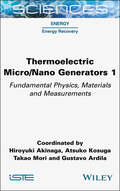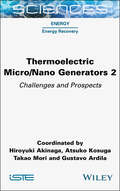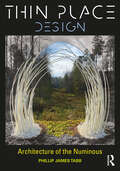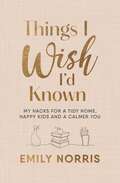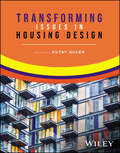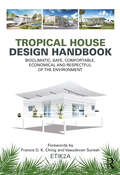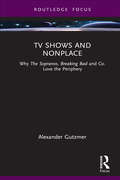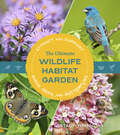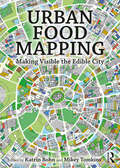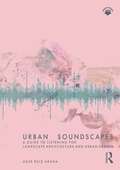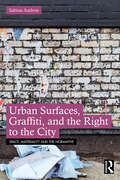- Table View
- List View
Teaching Landscape History
by Jan Woudstra David JacquesLandscape history is changing in content and style to address the issues of today. Experienced teachers and authors on the history of gardens and landscapes come together in this new volume to share ideas on the future of teaching history in departments of landscape architecture, archaeology, geography and allied subjects. Design history remains important, but this volume brings to the fore the increasing importance of environmental history, economic history, landscape history, cultural landscapes, environmental justice and decolonisation, ideas of sustainability and climate change amelioration, which may all be useful in serving the needs of a widening range of students in an increasingly complex world. The main themes include: what history should we narrate in the education of landscape architects? how can we recognise counter-narratives and our own bias? how should we engage the students in the history of their chosen profession? how can designers and researchers be persuaded of the relevance of history teaching to theory and practice? and what resources do we need to develop teaching of landscape histories? This book will be of interest to anyone teaching courses on landscape architecture, urban design, horticulture, garden design, architectural history, cultural geography and more.
Textiles for Residential and Commercial Interiors: - with STUDIO
by MaryPaul Yates Adrienne ConcraLearn how to choose the right type of textile for your residential and commercial interior design. This book includes important information about fiber and fabrics for household and institutional textiles, and commercial and residential textiles. It also touches on specific design techniques such as the latest textile printing methods and technologies, the newest performance-related finishes, proper window treatment, and the best environmentally conscious sustainability approaches. The line drawings and photographs show yarns, weaving, manufacturing equipment, fibers, fabrics used in a variety of interior spaces, and many more. New to this Edition- Updated to include the newest codes and guidelines for fabric performance and evaluation - Exploration of new textile printing methods and technologies- Updated fire safety methods and flammability testing STUDIO Features Include- Study smarter with self-quizzes featuring scored results and personalized study tips- Review concepts with flashcards of terms and definitions Instructor Resources- Instructor's Guide to help integrate the text into your classroom- PowerPoint slides for every chapter
Theatre Buildings: A Design Guide
by Association of British Theatre Technicians (ABTT) Margaret ShewringIn 2021, its Diamond Jubilee year, the Association of British Theatre Technicians (ABTT) undertook to revise Theatre Buildings: A Design Guide (Routledge, 2010). This new edition (Routledge, 2023) has substantially re-written text with fresh images and entirely new reference projects, providing essential guidance for all those engaged in the design of theatre buildings. Edited by Margaret Shewring (Emeritus Reader, University of Warwick, former Director of the Postgraduate Diploma and MA in Theatre Consultancy), this new publication is written by a team of international experts, architects, theatre consultants, acousticians, engineers and industry professionals led by Tim Foster (Foster Wilson Size) and Robin Townley (CEO of the ABTT). It provides an invaluable resource for those looking to build, remodel or conserve theatre buildings, taking into account the significant changes which have taken place in the last twelve years in all aspects of theatre design and technical practice. It locates those changes in the wider context of the need for sustainability in the theatre industry in response to the climate emergency, inclusivity, diversity of access, placemaking and concerns for health and wellbeing. This new edition provides guidance for anyone who seeks inspiration and encouragement to create or improve a place of entertainment or who seeks to understand what might be required to accommodate an audience for the presentation of live performance and the successful use, operation and organisation of such a venue. Its generous format and the thirty-two new reference projects, more than 260 high-resolution colour images and 175 diagrams and specially commissioned plans make it accessible and informative both to the general reader and the professional specialist.
Theatre Buildings: A Design Guide
by Margaret Shewring David HamerIn 2021, its Diamond Jubilee year, the Association of British Theatre Technicians (ABTT) undertook to revise Theatre Buildings: A Design Guide (Routledge, 2010). This new edition (Routledge, 2023) has substantially re-written text with fresh images and entirely new reference projects, providing essential guidance for all those engaged in the design of theatre buildings. Edited by Margaret Shewring (Emeritus Reader, University of Warwick, former Director of the Postgraduate Diploma and MA in Theatre Consultancy), this new publication is written by a team of international experts, architects, theatre consultants, acousticians, engineers and industry professionals led by Tim Foster (Foster Wilson Size) and Robin Townley (CEO of the ABTT). It provides an invaluable resource for those looking to build, remodel or conserve theatre buildings, taking into account the significant changes which have taken place in the last twelve years in all aspects of theatre design and technical practice. It locates those changes in the wider context of the need for sustainability in the theatre industry in response to the climate emergency, inclusivity, diversity of access, placemaking and concerns for health and wellbeing. This new edition provides guidance for anyone who seeks inspiration and encouragement to create or improve a place of entertainment or who seeks to understand what might be required to accommodate an audience for the presentation of live performance and the successful use, operation and organisation of such a venue. Its generous format and the thirty-two new reference projects, more than 260 high-resolution colour images and 175 diagrams and specially commissioned plans make it accessible and informative both to the general reader and the professional specialist.
Theorizing Built Form and Culture: The Legacy of Amos Rapoport (Routledge Research in Architecture)
by Kapila D. Silva Nisha A. FernandoIn this collection of essays, Theorizing Built Form and Culture: The Legacy of Amos Rapoport – a felicitation volume to celebrate the significance of Professor Amos Rapoport's lifelong scholarship – scholars from around the world discuss the analytical relevance, expansion, and continuing application of these contributions in developing an advanced understanding of mutual relationships between people and built environments across cultures.Professor Amos Rapoport has espoused an intellectual and theoretical legacy on environmental design scholarship that explains how cultural factors play a significant role in the ways people create and use environments as well as the way environments, in turn, influence people’s behavior. This volume presents a hitherto-not-seen, unique, and singular work that simultaneously articulates a cohesive framework of Rapoport’s architectural theories and demonstrates how that theoretical approach be used in architectural inquiry, education, and practice across environmental scales, types, and cultural contexts. It also acknowledges, for the very first time, how this theoretical legacy has pioneered the decolonizing of the Eurocentric approaches to architectural inquiry and has thus privileged an inclusive, cross-cultural perspective that laid the groundwork to understand and analyze non-Western design traditions. The book thus reflects a wide range of cross-cultural and cross-contextual range to which Professor Rapoport’s theories apply, a general notion of theoretical validity he always advocated for in his own writings.The volume is a paramount source for scholars and students of architecture who are interested in understanding how culture mediates the creation, use, and preservation of the built environment.
Theorizing Built Form and Culture: The Legacy of Amos Rapoport (Routledge Research in Architecture)
In this collection of essays, Theorizing Built Form and Culture: The Legacy of Amos Rapoport – a felicitation volume to celebrate the significance of Professor Amos Rapoport's lifelong scholarship – scholars from around the world discuss the analytical relevance, expansion, and continuing application of these contributions in developing an advanced understanding of mutual relationships between people and built environments across cultures.Professor Amos Rapoport has espoused an intellectual and theoretical legacy on environmental design scholarship that explains how cultural factors play a significant role in the ways people create and use environments as well as the way environments, in turn, influence people’s behavior. This volume presents a hitherto-not-seen, unique, and singular work that simultaneously articulates a cohesive framework of Rapoport’s architectural theories and demonstrates how that theoretical approach be used in architectural inquiry, education, and practice across environmental scales, types, and cultural contexts. It also acknowledges, for the very first time, how this theoretical legacy has pioneered the decolonizing of the Eurocentric approaches to architectural inquiry and has thus privileged an inclusive, cross-cultural perspective that laid the groundwork to understand and analyze non-Western design traditions. The book thus reflects a wide range of cross-cultural and cross-contextual range to which Professor Rapoport’s theories apply, a general notion of theoretical validity he always advocated for in his own writings.The volume is a paramount source for scholars and students of architecture who are interested in understanding how culture mediates the creation, use, and preservation of the built environment.
The Therapeutic Power of the Maggie’s Centre: Experience, Design and Wellbeing, Where Architecture meets Neuroscience
by Caterina FrisoneThis book is about the therapeutic environment of the Maggie’s centre and explores the many ways this is achieved. With an unconventional architecture as required by the design brief, combined with Maggie’s psychological support programme, this special health facility allows extraordinary therapeutic effects in people, to the point that one can speak of therapeutic power.After tracing the story of the Maggie’s centre, the book reveals its fundamentals: Maggie’s Therapeutikos (the-mind-as-important-as-the-body), the Architectural Brief and the ‘Client-Architect-Users’ Triad. It continues by unfolding Maggie’s synergy-that between people and place-which increases users’ psychological flexibility helping them tolerate what was intolerable before. Although comfort and atmospheres are paramount, they are not enough to define the therapeutic environment of the Maggie’s centre. Only by looking at neuroscience that can give us scientific explanations of empathy, feelings and emotions and only considering space neither neutral nor empty, but full of forces that envelop people in an embodied experience, can we explain what generates wellbeing in a Maggie’s centre.The book concludes by critically evaluating the Maggie’s centre as a model to be applied to other healthcare facilities and to architecture in general. It is essential reading for any student or professional working on therapeutic environments.
The Therapeutic Power of the Maggie’s Centre: Experience, Design and Wellbeing, Where Architecture meets Neuroscience
by Caterina FrisoneThis book is about the therapeutic environment of the Maggie’s centre and explores the many ways this is achieved. With an unconventional architecture as required by the design brief, combined with Maggie’s psychological support programme, this special health facility allows extraordinary therapeutic effects in people, to the point that one can speak of therapeutic power.After tracing the story of the Maggie’s centre, the book reveals its fundamentals: Maggie’s Therapeutikos (the-mind-as-important-as-the-body), the Architectural Brief and the ‘Client-Architect-Users’ Triad. It continues by unfolding Maggie’s synergy-that between people and place-which increases users’ psychological flexibility helping them tolerate what was intolerable before. Although comfort and atmospheres are paramount, they are not enough to define the therapeutic environment of the Maggie’s centre. Only by looking at neuroscience that can give us scientific explanations of empathy, feelings and emotions and only considering space neither neutral nor empty, but full of forces that envelop people in an embodied experience, can we explain what generates wellbeing in a Maggie’s centre.The book concludes by critically evaluating the Maggie’s centre as a model to be applied to other healthcare facilities and to architecture in general. It is essential reading for any student or professional working on therapeutic environments.
Thermoelectric Micro / Nano Generators, Volume 1: Fundamental Physics, Materials and Measurements
by Hiroyuki Akinaga Atsuko Kosuga Takao Mori Gustavo Adolfo Ardila RodriguezThis book explores a key technology regarding the importance of connections via an Internet of Things network and how this helps us to easily communicate with others and gather information. Namely, what would happen if this suddenly became unavailable due to a shortage of power or electricity? Using thermoelectric generators is a viable solution as they use the heat around us to generate the much-needed electricity for our technological needs. This first volume explores the computational and data-driven development of these thermoelectric generators, as well as the use of various abundant materials such as copper and silver chalcogenides and nanocarbons. It also offers reviews on universal property enhancement principles and the case of strongly correlated oxides, and goes on to explore the metrology of the thermal properties of thermoelectric generators, detailing methods of how to measure the absolute Seebeck coefficient using the Thomson effect and the thermal diffusivity of thin films using the ultrafast laser flash method.
Thermoelectric Micro / Nano Generators, Volume 2: Challenges and Prospects
by Hiroyuki Akinaga Atsuko Kosuga Takao Mori Gustavo Adolfo Ardila RodriguezThis book explores a key technology regarding the importance of connections via an Internet of Things network and how this helps us to easily communicate with others and gather information. Namely, what would happen if this suddenly became unavailable due to a shortage of power or electricity? Using thermoelectric generators is a viable solution as they use the heat around us to generate the much-needed electricity for our technological needs. This second volume on the challenges and prospects of thermoelectric generators covers the reliability and durability of thermoelectric materials and devices, the effect of microstructures on the understanding of electronic properties of complex materials, thermoelectric nanowires, the impact of chemical doping or magnetism, thermoelectric generation using the anomalous Nernst effect, phonon engineering, the current state and future prospects of thermoelectric technologies, transition metal silicides, and past, present and future applications of thermoelectrics.
Thin Place Design: Architecture of the Numinous
by Phillip James TabbWhat makes the places we inhabit extraordinary? Why are some urban spaces more vital and restorative? Wonderful landscapes, inspiring works of architecture and urban design, and the numinous experiences that accompany them have been an integral dimension of our culture. Up-lifting spaces, dramatic use of natural light, harmonic proportional geometry, magical landscapes, historic sites and vital city centers create special, even sacred moments in architecture and planning. This quality of experience is often seen as an aesthetic purpose intended to inspire, ennoble, ensoul and spiritually renew. Architecture and urban spaces, functioning in this way, are considered to be thin places.
Thin Place Design: Architecture of the Numinous
by Phillip James TabbWhat makes the places we inhabit extraordinary? Why are some urban spaces more vital and restorative? Wonderful landscapes, inspiring works of architecture and urban design, and the numinous experiences that accompany them have been an integral dimension of our culture. Up-lifting spaces, dramatic use of natural light, harmonic proportional geometry, magical landscapes, historic sites and vital city centers create special, even sacred moments in architecture and planning. This quality of experience is often seen as an aesthetic purpose intended to inspire, ennoble, ensoul and spiritually renew. Architecture and urban spaces, functioning in this way, are considered to be thin places.
Things I Wish I’d Known: My hacks for a tidy home, happy kids and a calmer you
by Emily Norris'Queen of the mothering hack. Emily Norris delivers ingenious ideas to make life a little bit easier!’ – Giovanna Fletcher, bestselling author and podcaster'Genius hacks to save time and bring a little more joy' – Anna Mathur, Psychotherapist and bestselling author'Packed with tips and ideas that make mum life *just* a little easier!' – Harriet Shearsmith, @tobyandrooI became obsessed with mum hacks when a friend showed me a game-changing tip during my baby days - that baby vests can be pulled down (not up) in the event of an explosive poo. I couldn't believe I had been a mum for so long and not known! Things I Wish I'd Known will bring you hundreds of quick and clever solutions, just like this, all to make the parenting juggle easier.You'll find my favourite hacks and habits, as well as dozens of new ones, all designed to give your day-to-day a lift. From cleaning hacks that leave your home sparkling in no time, laundry tricks that save you money, and simple tweaks to night-time routines which transform everyone's sleep, I'll show you how to hack every aspect of home-life so you feel less stress and more joy!Emily x
Transforming Issues in Housing Design
by Kutay GulerTRANSFORMING ISSUES IN HOUSING DESIGN A practical and complete resource for students, researchers, and practitioners of housing design Transforming Issues in Housing Design delivers a comprehensive vision for the design, philosophy, psychology, efficiency, and constitution of housing. This collection of articles explores many of the most pressing and relevant issues related to the ongoing transformation of housing design. Twenty-two contributed chapters discuss the past and current state of housing design, how it evolved to become what it is today, and, finally, how it may unfold in the future. A team of global experts presents the most up-to-date research and a diverse and illuminating collection of examples to highlight housing design around the world. Readers will also find: A thorough introduction to modern housing design and how it relieves and contributes to various social and economic problems Insightful explorations of the built environment, interior architecture, urban design, sustainable living, space planning, and more Practical discussions of a theoretical framework to make sense of housing design concepts Complete treatments of concepts, research, and built projects from a diverse range of communities and cultures Perfect for architects and students of urban studies, interior design, and architecture, Transforming Issues in Housing Design will also benefit those who design, research, and teach housing.
Transforming Issues in Housing Design
by Kutay GulerTRANSFORMING ISSUES IN HOUSING DESIGN A practical and complete resource for students, researchers, and practitioners of housing design Transforming Issues in Housing Design delivers a comprehensive vision for the design, philosophy, psychology, efficiency, and constitution of housing. This collection of articles explores many of the most pressing and relevant issues related to the ongoing transformation of housing design. Twenty-two contributed chapters discuss the past and current state of housing design, how it evolved to become what it is today, and, finally, how it may unfold in the future. A team of global experts presents the most up-to-date research and a diverse and illuminating collection of examples to highlight housing design around the world. Readers will also find: A thorough introduction to modern housing design and how it relieves and contributes to various social and economic problems Insightful explorations of the built environment, interior architecture, urban design, sustainable living, space planning, and more Practical discussions of a theoretical framework to make sense of housing design concepts Complete treatments of concepts, research, and built projects from a diverse range of communities and cultures Perfect for architects and students of urban studies, interior design, and architecture, Transforming Issues in Housing Design will also benefit those who design, research, and teach housing.
Tropical House Design Handbook: Bioclimatic, Safe, Comfortable, Economical and Respectful of the Environment
by Etik2aPacked with accessible information, this book covers all the technical and practical aspects of home design in tropical environments. . It begins by outlining the prerequisites needed to understand the issues involved (climate, heat, thermal comfort, etc.) and discusses the solutions offered by traditional housing. It then identifies current solutions for protecting buildings and their occupants from solar radiation and external heat, while promoting bioclimatic and environmentally friendly approaches. . The economic viability of the solutions identified is discussed, as are the advantages and disadvantages of the materials, depending on the context and standards in force. . Numerous examples illustrate how buildings can be adapted to local realities, from the avant-garde creations of Jean Prouvé to those of today’s architects who are committed to sustainable development, as well as specific projects incorporating the recommendations made in this book. More than 460 photos, drawings, diagrams, tables, maps, house plans, logos and pictograms illustrate this reference work for all those involved in construction in tropical regions, particularly students in the field and, more generally, anyone – from professionals to private individuals – looking for useful information on this subject.
Tropical House Design Handbook: Bioclimatic, Safe, Comfortable, Economical and Respectful of the Environment
by Etik2aPacked with accessible information, this book covers all the technical and practical aspects of home design in tropical environments. . It begins by outlining the prerequisites needed to understand the issues involved (climate, heat, thermal comfort, etc.) and discusses the solutions offered by traditional housing. It then identifies current solutions for protecting buildings and their occupants from solar radiation and external heat, while promoting bioclimatic and environmentally friendly approaches. . The economic viability of the solutions identified is discussed, as are the advantages and disadvantages of the materials, depending on the context and standards in force. . Numerous examples illustrate how buildings can be adapted to local realities, from the avant-garde creations of Jean Prouvé to those of today’s architects who are committed to sustainable development, as well as specific projects incorporating the recommendations made in this book. More than 460 photos, drawings, diagrams, tables, maps, house plans, logos and pictograms illustrate this reference work for all those involved in construction in tropical regions, particularly students in the field and, more generally, anyone – from professionals to private individuals – looking for useful information on this subject.
TV Shows and Nonplace: Why The Sopranos, Breaking Bad and Co. Love the Periphery (Routledge Focus on Television Studies)
by Alexander GutzmerThis book scrutinizes the relationship between contemporary TV shows and space, focusing on the ways in which these shows use and narrate specific spatial structures, namely, spaces far away from traditional metropolises. Beginning with the observation that many shows are set in specific spatial settings, referred to in the book as “nonplace territories” – e.g., North Jersey, New Mexico, or rural and suburban Western Germany – the author argues that the link between such nonplace territories and shows such as The Sopranos, Breaking Bad, or Dark is so intense because the narrative structure functions similarly to these territories: flat, decentralized, without any sense of structure or stable hierarchy. The book takes three different perspectives: first, it looks at the rationale for combining TV shows and nonplace territories from the viewpoint of narrative strategy. It then thinks through what these strategies mean for practicing architects. Finally, it approaches the arguments made before from a “user” perspective: what does this narrative mirroring of social-spatial reality in places such as Albuquerque or Jersey City mean for people living in these places? This new approach to architecture and space on screen will interest scholars and students of television studies, screen architecture, media and architectural theory, and popular culture.
TV Shows and Nonplace: Why The Sopranos, Breaking Bad and Co. Love the Periphery (Routledge Focus on Television Studies)
by Alexander GutzmerThis book scrutinizes the relationship between contemporary TV shows and space, focusing on the ways in which these shows use and narrate specific spatial structures, namely, spaces far away from traditional metropolises. Beginning with the observation that many shows are set in specific spatial settings, referred to in the book as “nonplace territories” – e.g., North Jersey, New Mexico, or rural and suburban Western Germany – the author argues that the link between such nonplace territories and shows such as The Sopranos, Breaking Bad, or Dark is so intense because the narrative structure functions similarly to these territories: flat, decentralized, without any sense of structure or stable hierarchy. The book takes three different perspectives: first, it looks at the rationale for combining TV shows and nonplace territories from the viewpoint of narrative strategy. It then thinks through what these strategies mean for practicing architects. Finally, it approaches the arguments made before from a “user” perspective: what does this narrative mirroring of social-spatial reality in places such as Albuquerque or Jersey City mean for people living in these places? This new approach to architecture and space on screen will interest scholars and students of television studies, screen architecture, media and architectural theory, and popular culture.
The Ultimate Wildlife Habitat Garden: Attract and Support Birds, Bees, and Butterflies
by Stacy TornioThis beginner-friendly handbook helps homeowners create a beautiful garden that attracts birds, bees, butterflies, and more. In The Ultimate Wildlife Habitat Garden, Stacy Tornio makes it easy to attract birds, bees, and butterflies to your home garden by sharing details about which plants attract specific creatures. Entice birds with black-eyed susans, attract bumblebees by planting bee balm, and more. Choose from ten garden plans, including a hummingbird garden, a birdseed garden, and options that are low-maintenance and drought-resistant. You&’ll also get advice on finding the right feeder, avoiding pesticides, and choosing native plants. This beautiful, photo-filled guide will enable you to create the earth-friendly garden of your dreams.
Urban Food Mapping: Making Visible the Edible City
by Katrin Bohn Mikey TomkinsWith cities becoming so vast, so entangled and perhaps so critically unsustainable, there is an urgent need for clarity around the subject of how we feed ourselves as an urban species. Urban food mapping becomes the tool to investigate the spatial relationships, gaps, scales and systems that underlie and generate what, where and how we eat, highlighting current and potential ways to (re)connect with our diet, ourselves and our environments.Richly explored, using over 200 mapping images in 25 selected chapters, this book identifies urban food mapping as a distinct activity and area of research that enables a more nuanced way of understanding the multiple issues facing contemporary urbanism and the manyfold roles food spaces play within it. The authors of this multidisciplinary volume extend their approaches to place making, storytelling, in-depth observation and imagining liveable futures and engagement around food systems, thereby providing a comprehensive picture of our daily food flows and intrastructures. Their images and essays combine theoretical, methodological and practical analysis and applications to examine food through innovative map-making that empowers communities and inspires food planning authorities. This first book to systematise urban food mapping showcases and bridges disciplinary boundaries to make theoretical concepts as well as practical experiences and issues accessible and attractive to a wide audience, from the activist to the academic, the professional and the amateur. It will be of interest to those involved in the all-important work around food cultures, food security, urban agriculture, land rights, environmental planning and design who wish to create a more beautiful, equitable and sustainable urban environment.
Urban Food Mapping: Making Visible the Edible City
by Katrin Bohn Mikey TomkinsWith cities becoming so vast, so entangled and perhaps so critically unsustainable, there is an urgent need for clarity around the subject of how we feed ourselves as an urban species. Urban food mapping becomes the tool to investigate the spatial relationships, gaps, scales and systems that underlie and generate what, where and how we eat, highlighting current and potential ways to (re)connect with our diet, ourselves and our environments.Richly explored, using over 200 mapping images in 25 selected chapters, this book identifies urban food mapping as a distinct activity and area of research that enables a more nuanced way of understanding the multiple issues facing contemporary urbanism and the manyfold roles food spaces play within it. The authors of this multidisciplinary volume extend their approaches to place making, storytelling, in-depth observation and imagining liveable futures and engagement around food systems, thereby providing a comprehensive picture of our daily food flows and intrastructures. Their images and essays combine theoretical, methodological and practical analysis and applications to examine food through innovative map-making that empowers communities and inspires food planning authorities. This first book to systematise urban food mapping showcases and bridges disciplinary boundaries to make theoretical concepts as well as practical experiences and issues accessible and attractive to a wide audience, from the activist to the academic, the professional and the amateur. It will be of interest to those involved in the all-important work around food cultures, food security, urban agriculture, land rights, environmental planning and design who wish to create a more beautiful, equitable and sustainable urban environment.
Urban Soundscapes: A Guide to Listening for Landscape Architecture and Urban Design
by Usue Ruiz AranaSound and listening are intrinsically linked to how we experience and engage with places and communities. This guide puts forward a new conceptual framework of embodied affectivity that emphasises listening in urban research and design and advances new ways of knowing and making. The guide invites landscape architects and urban designers to become soundscape architects and offers practical advice on sound and listening applicable to each stage of a design project: from reading the environment to intervening on it.Urban Soundscapes foregrounds listening as an affective mediator between subjects and multispecies environments, and a vehicle to think and conceptualise environmental research and design beyond prevailing visual and human-centred modes. The guide expands landscape architects’ and urban designers’ tools and skills to assess existing soundscapes, predict how those soundscapes will be altered through their designs, consider sound as a creative and active part of the design process and envisage how users might perceive and be affected by those soundscapes as they evolve in time. The volume sits in the interface of research and practice and interweaves theoretical, methodological and creative contributions from acoustic ecology, ecoacoustics, bioacoustics and sound art. Each of the design stages is illustrated through project examples that demonstrate the many advantages of incorporating attentive listening and sound into Landscape Architecture and Urban Design Practice. This book shows how incorporating listening and sounding as part of the design process promotes slow and subtle ways of practice, adds social and ecological value through the reduction of noise pollution and by monitoring the health of habitats, and enables the design of soundscapes that complement the character and design intent of a scheme and elicit joy and wonder.The book will be of interest to practitioners and academics in landscape architecture, and other design and spatial fields such as urban design, architecture, geography and engineering, who play a primary role in the composition of the soundscape.
Urban Soundscapes: A Guide to Listening for Landscape Architecture and Urban Design
by Usue Ruiz AranaSound and listening are intrinsically linked to how we experience and engage with places and communities. This guide puts forward a new conceptual framework of embodied affectivity that emphasises listening in urban research and design and advances new ways of knowing and making. The guide invites landscape architects and urban designers to become soundscape architects and offers practical advice on sound and listening applicable to each stage of a design project: from reading the environment to intervening on it.Urban Soundscapes foregrounds listening as an affective mediator between subjects and multispecies environments, and a vehicle to think and conceptualise environmental research and design beyond prevailing visual and human-centred modes. The guide expands landscape architects’ and urban designers’ tools and skills to assess existing soundscapes, predict how those soundscapes will be altered through their designs, consider sound as a creative and active part of the design process and envisage how users might perceive and be affected by those soundscapes as they evolve in time. The volume sits in the interface of research and practice and interweaves theoretical, methodological and creative contributions from acoustic ecology, ecoacoustics, bioacoustics and sound art. Each of the design stages is illustrated through project examples that demonstrate the many advantages of incorporating attentive listening and sound into Landscape Architecture and Urban Design Practice. This book shows how incorporating listening and sounding as part of the design process promotes slow and subtle ways of practice, adds social and ecological value through the reduction of noise pollution and by monitoring the health of habitats, and enables the design of soundscapes that complement the character and design intent of a scheme and elicit joy and wonder.The book will be of interest to practitioners and academics in landscape architecture, and other design and spatial fields such as urban design, architecture, geography and engineering, who play a primary role in the composition of the soundscape.
Urban Surfaces, Graffiti, and the Right to the City (ISSN)
by Sabina AndronThis landmark book focuses on urban surfaces, on exploring their authorship and management, and on their role in struggles for the right to the city.Graffiti, pristine walls, advertising posters, and municipal signage all compete on city surfaces to establish and imprint their values on our environments. It is the first time that the surfacescapes of our cities are granted the entire attention of a book as material, visual, and legal territories. The book includes a critical history of graffiti and street art as contested surface discourses and argues for surfaces as sites of resistance against private property, neoliberal creativity, and the imposition of urban order. It also proposes a seven-point manual for a semiotics of urban surfaces, laying the ground for a new discipline: surface studies.Page after page and layer after layer, surfaces become porous and political and emerge as key spatial conditions for rethinking and re-practicing urban dwelling and spatial justice. They become what the author terms the surface commons.The book will appeal to a wide readership across the disciplines of urban studies, architectural theory and design, graffiti, street art and public art, criminology, semiotics, visual culture, and urban and legal geography. It will also serve as a tool for city scholars, policy makers, artists, and vandals to disrupt existing imaginaries of order, justice, and visibility in cities.
